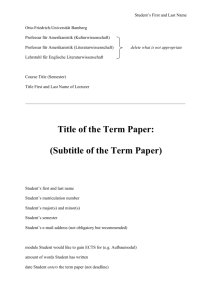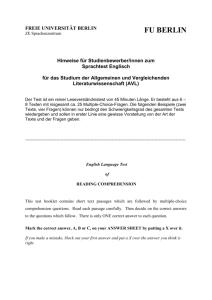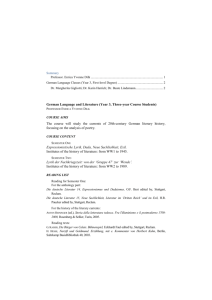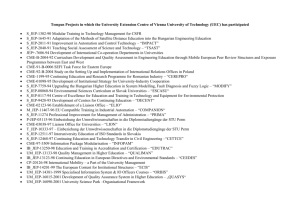Anarchosyndicalism and the Sexual Reform Movement in the
advertisement
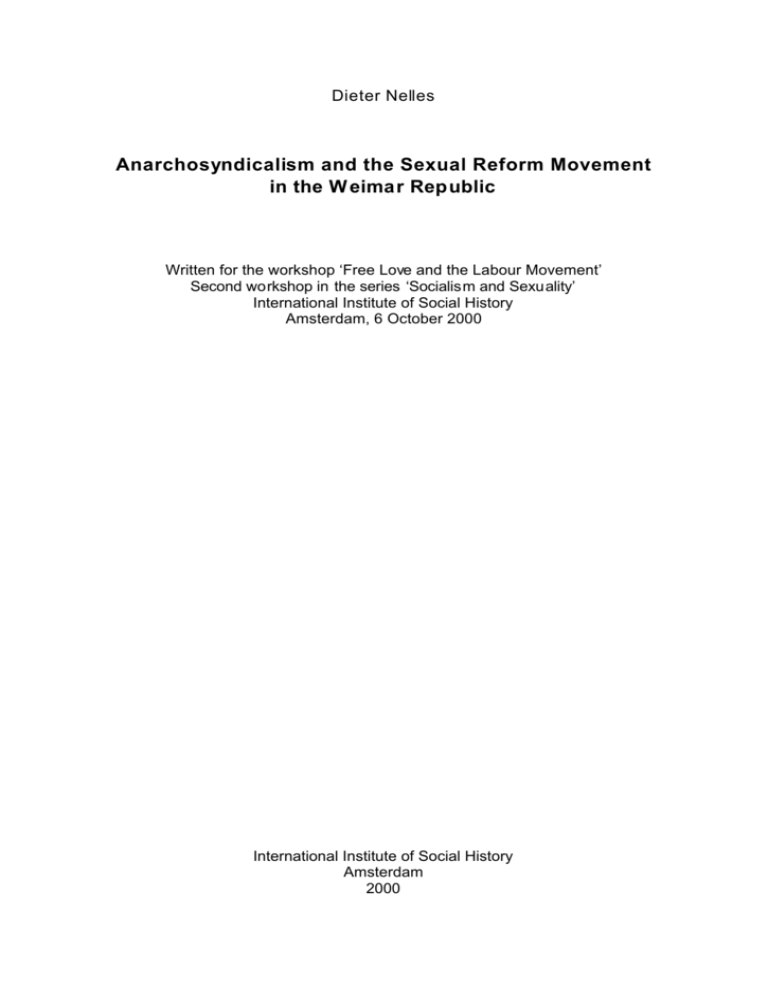
Dieter Nelles Anarchosyndicalism and the Sexual Reform Movement in the W eimar Republic Written for the workshop ‘Free Love and the Labour Movement’ Second workshop in the series ‘Socialism and Sexuality’ International Institute of Social History Amsterdam, 6 October 2000 International Institute of Social History Amsterdam 2000 “All workers’ organizations are concerned almost exclusively with economic and political issues. Both the parties and the unions view the issue of sex as being insignificant, irrelevant. There once was a time when it was considered to be unrespectable to publicly address problems concerning sexual relations. And yet it is so tremendously important that the sexual issue be addressed without any trace of reticence, just as is the hunger issue. For hunger and love are the two poles around which all human life and drive revolve. These two issues are so closely entwined that is hardly possible to discuss one without considering the other.”1 In 1925, the German anarchosyndicalist Max Winkler wrote these words as a preface to the pamphlet Das Geburtenproblem und die Verhütung der Schwangerschaft (The Population Problem and the Prevention of Pregnancy) in which the methods of contraception then popular were described matter-of-factly and in detail. Winkler's programmatic demands were taken seriously in the Freie Arbeiter Union Deutschlands, the FAUD (Free Worker's Union of Germany). The FAUD embraced the fundamental premise that the "sexual issue […was] not a private affair” but belonged “in the public eye and on the agenda of all workers’ organizations.”2 This conviction is illustrated not only by the many contributions on a broad range of aspects concerning sexuality found in FAUD publications, but more importantly by the major involvement in the sexual reform movement of many anarchosyndicalists, both men and women, in lay organizations, which developed in the 1920s into mass organizations with more than 150,000 members.3 Unlike elsewhere in Europe and the United States, the sexual reform movement in Germany was propagated chiefly by these lay organizations and not by physicians, intellectuals, or experts from the middle class. The history of these lay organizations has yet to be thoroughly researched. However, Hartmud Rübner has shown that the FAUD significantly influenced the establishment and policy of one of the most important lay organizations , the Reich Association of Birth Control and Sexual Hygiene or RV (Reichsverband für Geburtenregelung und Sexualhygiene).4 In the following contribution, I will outline the activities of the German anarchosyndicalists regarding sexual policies and their involvement in the sexual reform movement. The fact that “syndicalism [became] an important advocate of birth control for the proletariat in theory and practice” during the Weimar Republic is ascribed by Ulrich Linse to the enthusiastic response to the idea of a “childbearing strike” (Gebärstreikidee) in anarchist-syndicalist circles.5 In 1913, the Berlin physicians Alfred Bernstein and Julius Moses, both Social Democrats, propagated the “childbearing strike” as a “proletarian weapon.” This slogan was eagerly embraced by working class women, although not by the SPD executive committee nor by prominent Social Democratic women like Clara Zetkin and Rosa Luxemburg, who believed that abortion and contraception were “private affairs” to be discussed solely in a 1 Max Winkler, Das Geburtenproblem und die Verhütung der Schwangerschaft (Amsterdam, 1925), p. 1. Reference to the issue of the birthrate) to be found in Der Syndikalist, Organ der Freien Arbeiter Union Deutschlands, 3 (1921), no. 12. 3 See Atina Grossmann, Reforming Sex. The German Movement for Birth Control and Abortion Reform, 1920-1950 (New York, 1995); Cornelie Usborne, Frauenkörper – Volkskörper. Geburtenkontrolle und Bevölkerungspolitik in der Weimarer Republik (Münster, 1994), pp. 159-168. 4 See Hartmud Rübner, Freiheit und Brot. Die Freie Arbeiter-Union Deutschlands. Eine Studie zur Geschichte des Anarchosyndikalismus (Berlin etc., 1994), pp. 219-236. 5 Ulrich Linse, “Arbeiterschaft und Geburtenentwicklung im Deutschen Kaiserreich von 1871”, Archiv für Sozialgeschichte, 12 (1972), pp. 205-271, 252. 2 A N A R C H O S Y N D IC A L IS M A N D T H E SE X U A L R E F O R M M O V EM E N T 3 doctor’s office and the marital bedroom.6 At the request of the syndicalist organization Freie Vereinigung deutscher Gewerkschaften or FVDG (Free Association of German Unions), Bernstein wrote the pamphlet Wie fördern wir den kulturellen Rückgang der Geburten? (How can we promote the cultural decline of births?) that was printed in September 1913 by the FVDG publishing house.7 This pamphlet sold rapidly, due most likely also to the practical advice on contraception offered in it: 31,000 copies had been sold by May 1914.8 Propaganda for a childbearing strike, as a method of birth control, was again promoted after the war, particularly by the Syndikalistische Frauenbund or SFB (Syndicalist Women’s Union) established in 1920.9 In an article for the publication Der Frauenbund, Milly Witkop-Rocker wrote in 1921 that the “most important issue” that the SFB could address would be the “‘sexual issue’” because “the advancement in the intellectual development of women” could “not be possible without the liberation from the slavery of childbearing.”10 It appears that working class women embraced rather enthusiastically the propaganda for birth control because public meetings on the “childbearing strike” were very well attended11 and several local SFB groups were founded following such meetings.12 One anarchosyndicalist from Upper Silesia criticized: “Many women join the Womens’ Union only because they have specific questions about contraception. Once these are answered, they quit.”13 At public rallies, the FAUD and the SFB demanded continually the revocation of both the so-called “morality and sexual offenses paragraph”, §184.3 that criminalized the advocation of contraceptives, and the paragraph prohibiting abortions, §218.14 At these gatherings, physicians, legal experts, and writers also often 6 On the debate over the childbearing strike, see Anna Bergmann, Die verhütete Sexualität. Die Anfänge der modernem Geburtenkontrolle (Hamburg, 1992), pp. 286-292; Karl Heinz Roth, “Kontroversen um Geburtenkontrolle am Vorabend des Ersten Weltkrieges. Eine Dokumentation zur Berliner ‘Gebärstreikdebatte’ von 1913”, Autonomie, 9 (1978), pp. 78-103. 7 Alfred Bernstein, Wie fördern wir den kulturellen Rückgang der Geburten?. Ein Mahnruf an das arbeitende Volk (Berlin, 1913). 8 See Rübner, Freiheit und Brot, p. 221. For more on the discussion and reception of the childbearing-strike debate among anarchists and syndicalists, see Linse, Arbeiterschaft und Geburtenentwicklung, pp. 250ff.; Hubert van den Berg: “‘Frauen, besonders Frauenrechtlerinnen, haben keinen Zutritt!’ Misogynie und Antifeminismus bei Erich Mühsam”, IWK 28 (1992), pp. 479-510, p. 505ff. The feminist Helene Stöcker later recalled that “syndicalists and anarchists” had, even before 1913, “recommended methods of birth control at numerous gatherings as a means of self-help for the proletariat”. Quoted in Christiane Dienel, Kinderzahl und Staatsräson. Empfängnisverhütung und Bevölkerungspolitik in Deutschland und Frankreich bis 1918 (Münster, 1995), p. 180. 9 For more on the SFB, see Ulrich Klan and Dieter Nelles, Es lebt noch eine Flamme: Rheinische AnarchoSyndikalisten/-innen in der Weimarer Republik und im Faschismus (Grafenau, 1990), pp. 289-316; Cornelia Regin, “Hausfrau und Revolution. Die Frauenpolitik der Anarchosyndikalisten in der Weimarer Republik”, IWK 25 (1989), pp. 379-397; Rübner, Freiheit und Brot, pp. 184-192; Christine Weghoff, ““Die Frauenpolitik der Freien Arbeiter-Union Deutschlands (FAUD) 1921-1934. Eine Untersuchung auf der Grundlage ausgesuchter Quellen” (State examination thesis, University of Göttingen, 1984). 10 Milly Wittkop-Rocker: “Frauenarbeit – Frauenorganisationen”, Der Frauenbund. Monatsbeilage des Syndikalist, 1 (October 1921). 11 In Berlin, 2,200 men and women attended an event by the SFB in early 1921. See “Der Gebärstreik als antimilitaristische Waffe und Kulturhebel”, Der Syndikalist, 3 (1921), no. 12. 12 See Klan and Nelles, Es lebt noch eine Flamme, p. 298; “1. Reichskonferenz der syndikalistischen Frauenbünde Deutschlands”, Der Frauenbund, (1921), no. 1; “Oberschlesien”, Der Syndikalist, 4 (1922), no. 8. 13 Protokoll über die Verhandlungen vom 15. Kongreß der FAUD vom 10.-13.4. 1925 in Dresden (Berlin, 1925), p.69. 14 On the legal stipulations and restrictions, see Dienel, Kinderzahl und Staatsräson, pp. 68-71; Usborne, Frauenkörper, pp. 106-111, 201-229. A N A R C H O S Y N D IC A L IS M A N D T H E SE X U A L R E F O R M M O V EM E N T 4 spoke. A particularly close relationship existed to the neo-Malthusian sexual reformer Dr. Felix A. Theilhaber, who had founded the Society for Sexual Reform or Gesex (Gesellschaft für Sexual-Reform) in 1913. Beginning in 1925, Theilhaber published a nineteen-pamphlet series entitled “Beiträge zum Sexualproblem” (On the Sexual Issue) with the publishing house Der Syndicalist.15 This context explains the involvement of many anarchosyndicalists in the lay organizations that arose in many places across Germany in the early 1920s. In many cases, these organizations were founded by producers of contraceptives, who were interested in the lay organizations for business reasons stemming from the restrictions stipulated by §184.3. At least theoretically, the prohibitions of this paragraph could not be applied to so-called “closed-door events.” The commercial interests of these businessmen intersected with the interests of their working class customers for inexpensive contraceptives. Atina Grossmann refers to this as a “lively marriage of commerce and politics.”16 The influence of these businessmen began to diminish after 1923-4, and independent lay organizations for birth control were formed. Members of FAUD created in 1923 the Verein für Sexualhygiene und Lebensreform, or VSL (Association for Sexual Hygiene and Life Reform). The association set up its central office in Chemnitz and was active in Bavaria, Saxony, and Thuringia. Law enforcement authorities described this association in 1925 as “an association closely connected with the syndicalists, which recruited its members primarily from such circles.”17 In 1928, the VSL merged with other lay organizations to form the aforementioned RV. The Nuremberg FAUD functionary Franz Gampe was elected chairman. By 1930, the RV had 15,526 members in 192 local groups and had extended its reach into Berlin-Brandenburg, Bremen, Hamburg, Württemberg and Lower Silesia. In addition, a number of regional associations and Gesex had joined as autonomous districts of the RV. In Berlin, Bremen, Delmenhorst and Sömmerda, FAUD functionaries assumed leading positions in the RV.18 It is also evident that anarchists and anarchosyndicalists, both men and women, were involved in lay organizations in other regions throughout Germany. In the Rhineland, anarchists and anarchosyndicalists were active in top positions of the Arbeitsgemeinschaft Freier Sexual-Reformer-Verein (Working Committee of the Free Sexual Reformers Association). 19 A systematic study of these lay organizations would undoubtedly reveal further evidence that anarchosyndicalists were extensively involved in these groups. The fact that FAUD succeeded in attaining “such an important function from the outset in an evolving mass movement”20 can only be explained by the fact that they 15 See also Corinna Kaiser, “Der ‘Kater-Konzern’. Ein Beitrag zur (anarcho)-syndikalistischen Verlagsgeschichte”, Schwarzen Faden, 2(1994), no. 49, pp. 62-69. For more on Theilhaber, see Hans Lehfeldt, “Felix A. Theilhaber – Pionier-Sexologe”, Archiv Bilbiografhia Judaica, annual 1 (1985), pp. 85-93. Lehfeldt, a colleague of Theilhaber's at Gesex, writes about Theilhaber's pamphlet series but does not mention that it was printed by an anarchosyndicalist publisher. 16 See Grossman, Reforming Sex, p. 16. 17 Quoted in Rübner, Freiheit und Brot, p. 224; see also Usborne, Frauenkörper, p. 160. 18 See Rübner, Freiheit und Brot, p. 228-231. 19 See. R. Theissen, P. Walter, and J. Wilhelms, Der Anarchosyndikalistische Widerstand an Rhein und Ruhr (Meppen, 1980), p. 91; “Der Schareina-Prozeß in Cleve; Protestversammlung der ‘Arbeitsgemeinschaft Freier Sexualreform-Verbände’”‚ Der Syndikalist 12 (1931), no. 24; Karl Börder to Pierre Ramus, september 8. 1931, in: IISG, Ramus papers. 20 Rübner, Freiheit und Brot, p. 225. A N A R C H O S Y N D IC A L IS M A N D T H E SE X U A L R E F O R M M O V EM E N T 5 attributed such great importance to the “sexual issue” and that they did not use their involvement in the lay organizations as a tactical instrument to organize workers, as did the KPD. On the contrary, Franz Gampe emphasized in 1928 in the Syndicalist that the RV was, in his words, “strictly neutral with regard to party politics, unions, and religion.”21 Because Gampe and other anarchosyndicalists, who regularly published articles in the RV magazine Sexualhygiene, held to this principle, it has been often thought that the RV members were "primarily neoMalthusians and Socialists"22 or favored the SPD politically.23 Whereas the latter was perhaps true for the majority of the physicians who cooperated with the RV, it was not so for the functionaries. 24 In 1932, Hans Lehfeldt, a member of Gesex and the head of an RV sexual counseling center, summarized the goals of the lay organizations as follows: “preferably sexual education, the struggle for sexual and penal reform, the distribution of contraceptives to members.”25 For good reason, Lehfeldt did not mention that the lay organization also helped in cases of unwanted pregnancies. Women seeking help were sent to sympathizing doctors in as far as the lay organization had contact with such physicians. However, only a very few women actually received professional help because the vast majority of the medical profession supported the ban on abortion and were critical of the activities of lay organizations.26 This explains why the RV, with its approximately 200 local groups nationwide, only found doctors in four major cities–Berlin, Hamburg, Nuremberg, and Stuttgart–who openly supported the association.27 Therefore, abortions were also performed by members of the lay organizations. Hans Schmitz, who was born in 1914 and whose father was a leading activist in the FAUD and the “Liga für Mutterschutz und soziale Familienhygiene” (League for the Protection of Mothers and Social Family Hygiene) in Wuppertal, recalled in his writings: “Father was active in the League […] Secretly it [the League] also aided women in getting abortions. There were several women who could be called upon when an abortion was to be performed. My mother had quite a bit of experience in this and was one of these women. Naturally we were not allowed to be around, but the apartment was so small that it could not be concealed from us. […] A couple of times, my mother sent me to fetch Dr B. […] He came when there were complications or to perform the curettage after my mother had induced the abortion.”28 There are four known cases in which individual anarchosyndicalists were sentenced. In 1930, a woman and FAUD activist named Albrecht was sentenced to three years of imprisonment in a highly publicized trial because she had per21 Fraga [Franz Gampe], “Bevölkerungspolitik und Geburtenrückgang” Der Syndikalist 10 (1928), no. 37. See Kristine von Soden, Die Sexualberatungsstellen der Weimarer Republik 1919-1933 (Berlin, 1988), p. 87. 23 See Grossmann, Reforming Sex, p. 31. 24 In addition to FAUD functionaries, other people active in the lay organizations appear to have been in particular members of socialist and communist cells. 25 Hans Lehfeldt, “Die Laienorganisationen für Geburtenregelung”, Archiv für Bevölkerungspolitik, Sexualethik und Familienkunde, 2 (1932), pp. 63-87, 64. 26 See von Soden, Die Sexualberatungsstellen, p. 140ff.; In an obituary for the Berlin surgeon Dr Jaquet, the FAUD wrote that he had not charged working class women for the abortions he performed for them. See Rübner, Freiheit und Brot, p. 228. 27 See Grossmann, Reforming Sex, p. 24; von Soden, Die Sexualberatungsstellen, p. 78. 28 Reiner Rhefus, Spurensicherung 1920. Der Arbeiteraufstand gegen den Kapp-Putsch und die damalige Arbeiterkultur im Bergischen Land (Essen, 2000), p. 102. 22 A N A R C H O S Y N D IC A L IS M A N D T H E SE X U A L R E F O R M M O V EM E N T 6 formed more than 100 abortions for the local chapter of the Volksbund für Mutterschutz und Sexualhygiene (League for the Protection of Mothers and Sexual Hygiene) in Hindenburg in Upper Silesia.29 Luise Wich from Ludwigshafen was sentenced in 1933 to a prison term of eighteen months. 30 Otto Bach, chairman of the RV in Sömmerda in Thuringia, was sentenced to prison.31 After the war, the wife of Franz Gampe sat in pretrial detention in Nuremberg, charged with illegal abortion.32 Women in the lay organizations appeared in particular to have, as the Communist Arbeiter-Illustrierte Zeitung (AIZ) wrote about Mrs. Albrecht, “attained medical expertise with the greatest degree of thoroughness” in order to perform abortions. The AIZ expressly stated that these women were “no bunglers” and had not accepted any money for the abortions. 33 In light of the estimated one million abortions performed in 1930, the work of the lay organizations cannot be valued highly enough. They offered sex education, informed people about birth control methods and contraceptives, and distributed these cheaply to those seeking help. In this way, they contributed significantly to the sexual emancipation of the working class. However, this “sexual revolution” as Atina Grossmann calls it, was complex and contradictory. “Although sexual gratification for women was called for, it was proclaimed and defined primarily by men.”34 This assessment also holds true for the FAUD, despite the fact that it was more open than other workers’ organizations with regards to issues of sexuality. “We experience repeatedly,” noted Trautchen Caspers, an activist in FAUD and the SFB in Süchteln (Rheinland), “that the men in our movement view women only as slaves, maids, and birthing machines, but not as people and comrades.”35 Trautchen Caspers was one of the few proletarian women in the FAUD who propagated and practiced the ideal of “free love.”36 Her definition of this ideal was anything but “a purified form of bourgeois marriage” (that was otherwise advocated among working class anarchists. She wrote about this in the Syndikalist: “Even we proletarians should know that human freedom also includes sexual relations. One can often observe how a man, due to his dominating position, forces the woman to submit to him, although he knows that her love is directed elsewhere. Such behavior is just as contemptible as that of the lecher who rapes a defenseless girl. This covetousness to own a women alone is barbaric and a glaring contradiction to the widely proclaimed equality of women.” At the same time, she believed that “sexual satisfaction without love (led) to perversity.”37 Her views and her lifestyle 29 See Rübner, Freiheit und Brot, p. 230. See Der Arbeitslose, 4 (March 1933); Stapo-Außenstelle Ludwigshafen to Stapo-leitstelle Neustadt an der Weinstr, february, 3. 1938, Landesarchiv Speyer, H 91, no. 1287. Luise Wich had already been sentenced in 1929 to a four-month imprisonment because of “attempted abortion”. 31 Frank Havers, “Die Freie Arbeiter-Union Deutschlands in Sömmerda (Thüringen) von 1919 bis 1933” (Masters thesis, University of Bochum, 1997), p. 105. 32 This is implied in an letter from Franz Gampe to Rudolf Rocker, 22 August 1948, IISG, Archive Rocker, no. 114. 33 AIZ, nr. 12, 131, reprinted in: Karen Hagemann (ed), Eine Frauensache. Alltagsleben und Geburtenpolitik 1919-1933 (Pfaffenweiler, 1991), p. 93f. 34 Atina Grossmann, “Die ‘Neue Frau’ und die Rationalisierung der Sexualität in der Weimarer Republik”, Ann Snitow, Christine Stansell, Sharon Thompson (eds), Die Politik des Begehrens. Sexualität, Pornographie und neuer Puritanismus in den USA (Berlin, 1985), pp. 38-62, 40. 35 Protokoll des 15. Kongresses der FAUD, p. 69. 36 For more on Trautchen Caspers, see. Klan and Nelles, Es lebt noch eine Flamme, pp. 305ff.; 313f. 37 Trautchen Caspers, “Etwas über die Freie Liebe”, Der Syndikalist 8 (1926), no. 5. 30 A N A R C H O S Y N D IC A L IS M A N D T H E SE X U A L R E F O R M M O V EM E N T 7 made Trautchen Caspers an exceptional case in the FAUD. But there were indeed other proletarian women in the FAUD who thought and lived in a similar fashion. This is illustrated, for example, by the correspondence between the abovementioned Luise Wich and her husband, Georg, who emigrated in 1933, in which there is proof that the sexual autonomy of women was not only a theoretical topic among the grassroots activists within the FAUD.38 38 See the correspondence, Landesarchiv Speyer, H 91, no. 1287.



